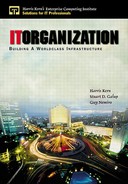Splitting the Technologies
In the mainframe-only world, each information systems subgroup (e.g., applications, technical support, etc.) handled its respective technical responsibilities in a coordinated manner, but the system and application software were designed to run basically separate from each other. The integration between the application layer and the system software layer was designed to be hierarchical, such as by permitting the applications group to develop programs and pass the source code to the production environment for compilation. System administration was not a concern for the applications programmer. This is not true in the client/server world.
Client/server technology is divided into three layers: presentation layer, business-code layer, and data layer. The presentation layer's purpose is to manage user-interface functions such as mouse clicks, scroll bars, and the visual layout. The business-code layer is the middle tier, and its purpose is to enforce business rules through programmable constructs such as requiring that purchase orders must reference a vendor. This is where the algorithms execute and the general data manipulation occurs. Layer three is the data or database tier. The purpose of this layer is to manage data storage and retrieval such as storing a record or executing a query. Now, depending on the type of client/server configuration you are deploying, the layer's basic function may be enhanced to also perform additional activities. For instance, there are light clients, light servers, heavy clients, and heavy servers. The general direction today is towards light clients and heavy servers because of the dramatic growth of the Internet and Web-based programming. The major software companies (SAP, Oracle, Peoplesoft, etc.) are all transitioning to light clients and heavy servers using a three-tier architecture.
What is a three-tier architecture? Well, client/server comes in two basic configurations, two-tier and three-tier. Two-tier client/server uses a presentation layer and a data layer, and places the process code either on the client or the server. Three-tier client/server splits the presentation, process, and data layers on separate computing complexes. In some deployments of three-tier, multiple process and data servers are used to permit linear growth. Therefore, utilizing cheaper personal computer complexes provides similar performance compared to what the traditional mainframe offered, as the end user on a PC or Macintosh uses a Web browser to matriculate the application. In this sense the end user's PC acts somewhat like a dumb terminal. A traditional mainframe environment was like a one-tier architecture, although there was a separation of the presentation, process, and data layers. The difference is that all three layers executed on the same computing complex.
The client/server environment introduces new challenges and coordination issues. We now have many computing complexes to manage. The desktop and server may be cheaper, but the complexity of many computing complexes interacting in the multi-protocol network is difficult to manage. A client/server environment requires that we share resources on the desktop and the server. Yes, we shared resources on the mainframe, but there was a clearer delineation of software responsibilities. The natural hierarchy of the mainframe separated the application from the system software. An information systems department using Cobol for its application software language rarely needed to address memory conflicts caused by application software. Products such as CICS from IBM handled this for the applications programmer. In the client/server world, desktop conflicts are common more often than we would like.
So, we are beginning to see the first issue. How do we build information systems that use multiple computers and divide up the ownership and management of each layer (presentation, process, and data)? Second, who is ultimately responsible for the desktops, the process servers, and the data servers? Third, what are the rules of engagement that will permit the various groups that will touch the desktop and servers to coexist?
These are not simple questions and there are no easy solutions. This is were the politics begin and were the politics can kill an IT department.
